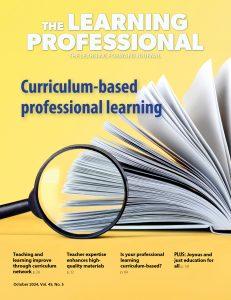The Redesign PD Community of Practice engages teams from 22 of the nation’s leading school districts and charter management organizations in identifying local professional learning challenges and creating scalable solutions. Learning Forward facilitates the community, where teams participate in continuous learning cycles to improve how they manage their professional learning systems.
When school districts focus on how to improve professional development, most of the time they concentrate on learning opportunities for teachers. But in Aspire Public Schools, leaders are expanding learning options for noninstructional staff members as well, with the mindset that everyone in a school contributes to students’ growth and development. Read about how they are expanding learning opportunities for all team members.
As part of the Redesign PD Community of Practice, facilitated by Learning Forward, Aspire Public Schools has worked to create more coherent professional learning pathways. But something was missing.
“We felt like we were leaving out a lot of people that were not teachers,” says Thomas Madson, senior director of the Early College High School program and a member of Aspire’s Redesign PD Community of Practice team. “We wanted them to have some connection to the work being done in the classrooms.”
Expecting nonteachers to attend professional learning sessions on curriculum didn’t seem right, and Madson says they didn’t want campus monitors, cafeteria workers, and even staff members working in the California and Tennessee regional offices to attend professional development just for the sake of attending. But a topic such as social-emotional learning is a “perfect inroad for developing nonteachers and teachers at the same time,” he says. “Campus monitors might not even have a diploma, but how can we help them develop?”
Getting Staff Input
Aspire began expanding professional learning for nonteaching staff members on a pilot basis last fall in two of its four regions — the Bay Area and the Central Valley in California. To inform the process of expanding opportunities for all staff members, Madson’s team also surveyed them on what they would want to learn. “It can’t be a home office mandate,” he says.
Social-emotional learning and restorative practices were two of the frequently suggested topics. Madson adds that noninstructional staff members might not understand how complex and challenging the Common Core standards are for students, but that they can learn strategies to support students outside of the classroom.
Some of the new topics were presented during a regional professional development day last fall, and the goal for next school year is for regional offices and school sites to move toward having one professional learning day each month. In the future, these learning opportunities will also be tied to each team member’s learning plan. Counselors, for example, might learn about new college or scholarship matching programs, and business managers might gain support on using databases.
Michelle Icenogle, Aspire’s director of student and family supports, says being part of the Redesign PD Community of Practice helped guide her work around integrating school counselors into the professional development opportunities that take place for teachers as well as improving teachers’ learning in learning social-emotional areas.
“The seeds that were planted at the Learning Forward convenings are being nurtured for the future,” she says, adding that, through the community, she has “gained a broader understanding of the leading-edge thinking that is occurring in the area of professional development. It was eye-opening for me, for example, to see that many districts have core teams in charge of supporting teacher and staff growth and what they were able to do, analyze, and create.”
With changes in leadership at Aspire in recent months, Madson says the Redesign PD Community’s support in the area of change management has also been especially helpful.
“The experience of other districts and [charter management organizations] regarding organization-wide change has also been invaluable — lessons learned, unforeseen challenges, and additional resources to name a few,” he says. “We have an opportunity to change the ways we think about PD and the ongoing supports necessary to realize our ambitious student outcomes.”
This post originally appeared in Learning Forward’s PD Watch.





